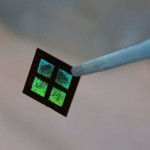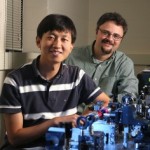News Category
John Wilson receives NSF Career Award
Apr. 5, 2016—John T. Wilson, assistant professor of chemical and biomolecular engineering, has received a National Science Foundation Faculty Early Career Development award. The five-year, $500,000 grant – Engineering Polymeric Nanomaterials for Programming Innate Immunity – will allow Wilson to develop new synthetic materials for “encoding” immunological messages and tightly regulating their delivery to the organs, cells,...
Alice Leach (IMS graduate student) part of team MERLIN: Winners of the 2016 TechVenture Challenge
Apr. 1, 2016—Wednesday saw the completion of yet another successful TechVenture Challenge. After six years, we are still encouraged that each year the presentations continue to improve and be of higher quality. This can be attributed not only to the student teams and their hard work, but also to the student organizers who improve upon the competition...
24 high schools from 15 Middle TN counties are participating in the VINSE Field Trip in Spring 2016
Mar. 11, 2016—24 High Schools representing 15 Middle TN counties are participating in the Spring 2016 VINSE high school field trip program. Groups of up to 20 from each school will to visit our facilities, perform an experiment, utilize our electron microscope, and learn about nanotechnology and energy during a day visit. Spring 2016 Participating Schools: Big Picture...
How to make electric vehicles that actually reduce carbon
Mar. 3, 2016—An interdisciplinary team of scientists has worked out a way to make electric vehicles that only are not only carbon neutral but carbon negative, capable of actually reducing the amount of atmospheric carbon dioxide as they operate. They have done so by demonstrating how the graphite electrodes used in the lithium-ion batteries that power electric...
IMS graduate student Alice Leach (Macdonald Lab) wins People’s Choice at 4th Annual Three Minute Thesis Competition
Mar. 1, 2016—Topics ranged from giving nanoparticles the aquatic skills of an Olympic swimmer so they can deliver anti-cancer drugs more effectively…to using game theory to help Sri Lankan farmers decide what crops to plant…to developing an ultrasonic Trojan horse to destroy tumors…to using blue light as an alternative to antibiotics in controlling bacterial infections. The event...
Dr. William Fissell’s Artificial Kidney
Feb. 15, 2016—Vanderbilt University Medical Center nephrologist and Associate Professor of Medicine Dr. William H. Fissell IV, is making major progress on a first-of-its kind device to free kidney patients from dialysis. He is building an implantable artificial kidney with microchip filters and living kidney cells that will be powered by a patient’s own heart. We are creating...
Cotton candy machines may hold key for making artificial organs
Feb. 11, 2016—Cotton candy machines may hold the key for making life-sized artificial livers, kidneys, bones and other essential organs. For several years, Leon Bellan, assistant professor of mechanical engineering at Vanderbilt University, has been tinkering with cotton candy machines, getting them to spin out networks of tiny threads comparable in size, density and complexity to the patterns...
Quantum dots made from fool’s gold boost battery performance
Nov. 11, 2015—If you add quantum dots – nanocrystals 10,000 times smaller than the width of a human hair – to a smartphone battery it will charge in 30 seconds, but the effect only lasts for a few recharge cycles. However, a group of researchers at Vanderbilt University report in the Nov. 11 issue of the journal ACS Nano that they...
Valentine featured on Phys.org and Vanderbilt Research News
Sep. 24, 2015—VINSE member Jason Valentine’s work published in Nature Communications was featured in Phys.org and Research News @ Vanderbilt 09/22/2015 “First circularly polarized light detector on a silicon chip” Invention of the first integrated circularly polarized light detector on a silicon chip opens the door for development of small, portable sensors that could expand the use...
First circularly polarized light detector on a silicon chip
Sep. 22, 2015—Invention of the first integrated circularly polarized light detector on a silicon chip opens the door for development of small, portable sensors that could expand the use of polarized light for drug screening, surveillance, optical communications and quantum computing, among other potential applications. The new detector was developed by a team of Vanderbilt University engineers...










